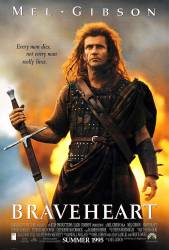Factual error: Princess Isabella was a 13-year-old girl living in France when William Wallace was executed in 1305. She didn't marry Prince Edward until 1308, and the marriage took place in Boulogne, not London.
Factual error: The Battle of Stirling (Bridge) is shown inaccurately in the film: the English and Scots line up on a battlefield and proceed to set about each other, with the Scots winning, with no bridge in sight. In the actual battle the English were crossing a bridge over the River Forth. The bridge was narrow, so they had to file down into small ranks. Wallace and the Scots waited at the top of a hill until half the army had crossed, then, before the English had time to regroup and form battle lines, the Scots charged down the hill and massacred the unprepared English.
Factual error: The film hints that Wallace is the father of Isabella's child (and the ancestor of all future kings and queens of England) but Isabella's baby (the future Edward III) was born in 1312, seven years after Wallace's execution in 1305.
Factual error: The voice-over at the beginning of the film tells us that Malcolm Wallace was a commoner with his own lands and constant references are made through-out the film to William being a commoner. However this is a common historical myth. Malcolm Wallace was in fact born as a minor noble and became a knight, as was William. They were poor as noble families went but were still infinitely more privileged than the commoners of the day.
Factual error: Malcolm Wallace had three sons: John, William, and Malcolm. He was not killed in a minor scuffle with the English. He, in fact, fought for several years with the English in order to free John de Baliol from the tower of London. At the time, Baliol was the rightful heir to the Scottish crown, and that was actually William's reason for fighting the English. Robert the Bruce was the one who actually liberated Scotland, right?
Factual error: In the opening scene of the film a caption at the bottom of the screen tells us it is Scotland 1280 AD and the voice-over tells us the King of Scotland had died without an heir etc. But Alexander III of Scotland did not die until 1286 AD.
Factual error: In the night scene after Malcolm Wallace's funeral we see the silhouette of a man playing bag pipes. Argyle tells William that they are outlawed tunes played on outlawed pipes. However, the bagpipes have only ever been banned twice in Scotland: in 1560 after the Reformation and again in 1746 after the Battle of Culloden (evidence for bans on bagpipes in the 18th century is weak at best). In the late 13th Century the bagpipe enjoyed similar popularity in England, although Scottish bagpipes were particular to the region, and had an established cultural importance. Whether these early bagpipes were as strongly associated with highland culture as later forms of the instrument is unclear; lowland and border musical tradition is more closely linked with small pipes.
Factual error: At the battle of Falkirk, the Irish soldiers fighting for Edward change sides at the last moment and go over to fight with the Scots. In reality, there were no Irish troops present at the battle. The only troublemakers amongst the English army were the contingent of Welsh bowmen who showed a reluctance to fight Wallace but this was more out of fear rather than sympathy for the Scots.
Factual error: Scots did not wear the kilt until the 17th century. They wore the saffron shirt prior to that (in Braveheart's time).
Factual error: Prince Edward was not a mincing homosexual stereotype. His homosexuality did not become obvious until after he became king and started taking male 'favourites'. Before then he was regarded as the perfect prince.
Factual error: Throughout the film, Wallace is portrayed as a Highland clansman in traditional highland garb. This was done by Gibson to emphasise the Scottish/English conflict, but it is not historically accurate. In fact, Wallace was a Lowland knight from exactly the same ethnic background as the Anglo-Normans he was fighting and would have worn the same style of armour as they did.
Factual error: The title of the Duke of York did not yet exist in the 13th century - it was instituted only later and was normally used only by a younger son of the King.
Factual error: In the movie the Scots sack the English city of York. Actually they sacked the city of Carlisle.






Answer: It's called "A Gift of a Thistle" and it's on the soundtrack conducted by James Horner. Incidentally, the tune is a recurring theme throughout the film's music, and appears in several other songs on the soundtrack as well. Also in relation to the song, the flower was a thistle.
Krista